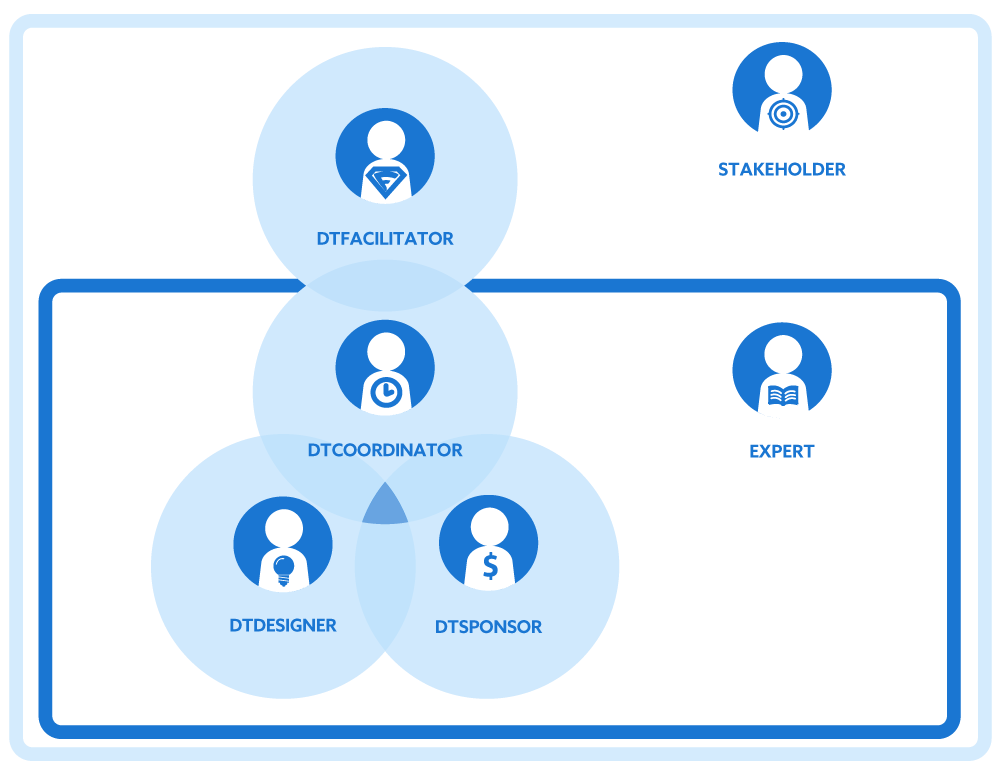DTRules&Roles


DTSponsor
• is not a member of the DTTeam,
• sets the Challenge for DTTeam to work on,
• selects and defines the scope of the Challenge,
• initiates and ends the DTMethod process


DTFacilitator
• organises work on the Solution,
• helps to effectively perform roles,
• adheres to the rules of work in DTMethod,
• is in constant contact with the DTSponsor


DTDesigner
• works as a part of the DTTeam,
• their role is to work on the Solution,
• each member of the team is selected from various areas and levels of organizational hierarchy,


DTCoordinator
• helps to schedule the meetingss between DTSponsor and DTFacilitator,
• sets a schedule of DTTeam’s tasks,
• coordinates administrative matters (contracts, deadlines, etc.),
• this role can be combined with the DTDesigner


Stakeholder
• a person in contact with the Solution,
• a source of data for DTDesigners in Exploration Phase,
• provides feedback which allows the DTTeam to improve the prototypes


Expert
• complements the DTTeam’s knowledge in a specific field,
• can be a one-time guest or work as a DTDesigner
Connecting roles in DTMethod
Almost anyone involved in the DTMethod can combine all available roles. The only exception is the DTFacilitator, who can combine this function only with DTCoordinator or who can be identified as a stakeholder.


Principles - the strict rules of work
Principles are indisputable, equally important and consistent rules, which have to be followed if the DTMethod is to be an effective model.


1. Focus on people
Design solutions, so they meet the Stakeholders’ needs. Work based on the knowledge that you gathered by studying them. Do not lean on stereotypes or your own convictions.


2. Team involvement
Provide DTDesigner with time and place for designing. Establish priorities and rules of engagement. Provide appropriate conditions which will allow you to develop a Solution.


3. Evidence-based approach
Act based on collected data. Avoid leaning on intuition and convictions. Base your actions on facts, think critically.


4. Phase
approach
In order to develop the best solution, all phases are essential. Go through each phase of the DTModel. Do not skip any of the steps.


5. Iterative approach
If needed, repeat previous steps to receive better effects. Draw conclusions based on the newly collected data.


6. Active
approach
It’s easy to lose drive and abandon tasks if there is no dynamics in actions. Do not delay any decisions. The sooner you start, the better.


7. Learning approach
In Design Thinking each success and failure is a lesson, as it allows to draw conclusions for the future. Use feedback to design the best Solution.
See the remaining components of the DTMethod
The methodology of Design Thinking,
process management stands on three pillars:
- DTModel, consisting of 3 phases,
- DTTools, around 20 tools adjusted to the DTModel,
- DTRules&Roles, i.e., the rules (and roles) that must be followed when using DTMethod.


Want to know more?
Contact us. We would be happy to discuss the details and arrange a training.